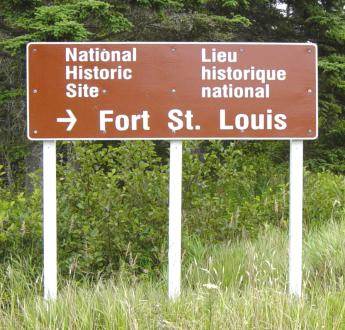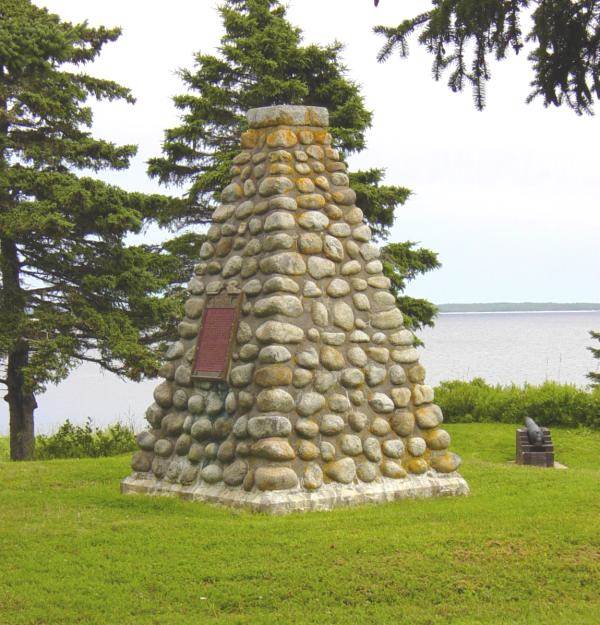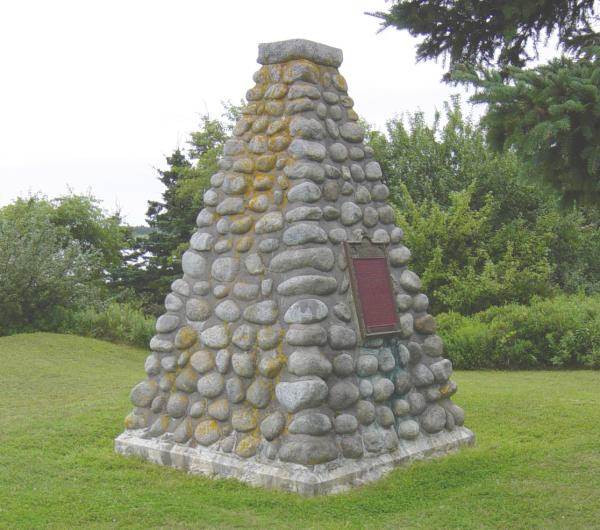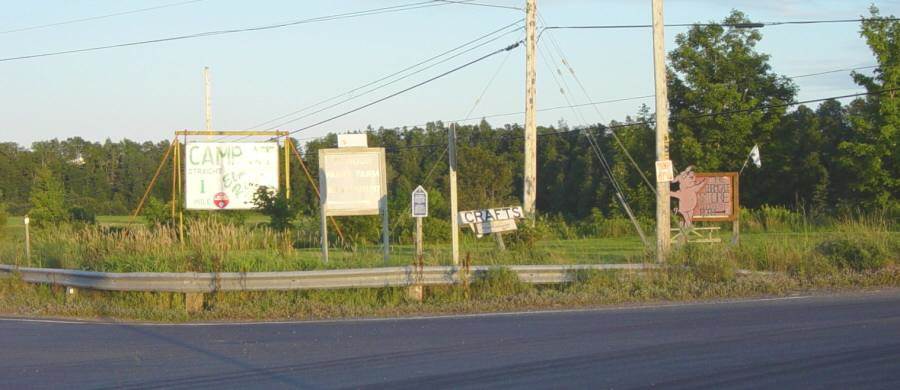
Fort St. Louis 1630
Claude de la Tour 1570 – 1636+
Charles de la Tour 1595 – 1666
National Historic Site
Fort Point, Port LaTour Shelburne County Nova Scotia
In the 1630s, this was the strongest military establishment
anywhere in what is now the Maritime Provinces or Maine.
In 1630-31, this was the strongest French military establishment
anywhere in what is now Canada.
This monument and plaque were officially unveiled in September 1937.
GPS location: 43°29’42″N 65°28’13″W

Photographed on 19 August 2003

Photographed on 19 August 2003

Plaque date: 1937
Photographed on 19 August 2003

Photographed on 19 August 2003
…The Baron de Poutrincourt died in 1615, leaving his estate to his son Biencourt. And after Biencourt’s own death in1623, it was found that he had bequeathed a considerable fortune, including all his property and rights in Acadia, to his friend and companion, that interesting and resourceful adventurer, Charles de laTour. This man, when a lad of fourteen, and his father, Claude de laTour, had come out to Acadia in the service of Poutrincourt. After the destruction of Port Royal, Charles de laTour had followed young Biencourt into the forest, and had lived with him the nomadic life of the Indians. Later, the elder LaTour established himself for trade at the mouth of the Penobscot, but he was driven away from this post by a party from the English colony at Plymouth. The younger LaTour, after coming into Biencourt’s property, built FortLomeron, afterwards named St.Louis, at the place now known as PortLatour, near Cape Sable. This made him in fact, if not in name, the French ruler of Acadia, for his Fort St.Louis was the only place of any strength in the whole country…
— Source: FullBooks.com
The Acadian Exiles, part 1 by Arthur G. Doughty, Toronto, 1916
Chronicles of Canada, in thirty-two volumes
Edited by George M. Wrong and H. H. Langton
Arthur G. Doughty Wikipedia
Sir Arthur G. Doughty Library and Archives Canada
The Acadian Exiles, by Arthur G. Doughty Project Gutenberg
Creditors Muddle Affairs After d’Aulnay’s Death
by Jim Bradshaw, Lafayette Daily Advertiser, 23 February 1999
Charles de la Tour returns from exile in Quebec to reclaim his fur trading lands…
http://www.carencrohighschool.org/la_studies/ParishSeries/
Acadie/LaTourReturnsFromExile.htm
Remembering Our Acadian Heritage
by Jim Bradshaw, Lafayette Daily Advertiser, 29 September 1994
…When Acadie was returned to France in 1632 under the Treaty of
Saint Germain-en-Laye, Cardinal Armand Jean du Plessis, Duc de Richelieu,
had come to power in France. He would prove himself one of the ablest of
French statesmen. He would hold strong influence over KingLouisXIII,
and would, in fact, be the actual ruler of France for more than 18years.
Richelieu saw the coming struggle for supremacy in North America, and
saw that France would have to strengthen its colonies there if it was going
to compete with the growing British strength…
http://www.carencrohighschool.org/la_studies/cajun/acad_mag.htm
Ministers in France take a dim view of La Tour attack
by Jim Bradshaw, Lafayette Daily Advertiser, 23 February 1999
http://www.carencrohighschool.org/la_studies/ParishSeries/
Acadie/MinistersinFrance.htm
Civil War in Acadia
…Acadia was from its beginnings a centre of conflict and competing ambitions.
Neglected by France, it was the victim of aggression whenever the privateering
spirit moved some New England adventurer. The most destructive conflict in the
early days, however, was among the French themselves, in particular between
the two most powerful characters in Acadian history. One was Charles de La Tour,
an ambitious, resourceful man – a born leader with the happy ability of inspiring
loyalty. The other was the equally ambitious, ruthless, intelligent and very well
connected Charles de Menou d’Aulnay…
http://www.thecanadianencyclopedia.com/index.cfm
?PgNm=ArchivedFeatures&Params=A279
List of Acadian governors
http://www.answers.com/topic/list-of-acadian-governors
Brief Biographies
Chapter 8: The Battling Barons of Acadia by Peter Landry
Razilly, d’Aulnay, La Tour, Denys…
http://www.blupete.com/Hist/NovaScotiaBk1/Part1/Ch08.htm
Claude de Saint-Etienne de la Tour (c.1570-c.1636) Dictionary of Canadian Biography
http://www.biographi.ca/EN/ShowBio.asp?BioId=34641
Charles La Tour (1595-c.1665) by Peter Landry
http://www.blupete.com/Hist/BiosNS/1600-00/LaTour.htm
Charles de Saint-Etienne de la Tour (1593-1666) Dictionary of Canadian Biography
http://www.biographi.ca/EN/ShowBio.asp?BioId=34640
Charles de Saint-Etienne de la Tour (c.1665-1731) Dictionary of Canadian Biography
http://www.biographi.ca/EN/ShowBio.asp?BioId=35212
Charles de Saint Etienne de la Tour by Universite Sainte-Anne, Church Point
http://epe.lac-bac.gc.ca/100/205/301/ic/cdc/acadian/
english/eb41755/lords/latour/latour.htm
Charles Turgis de St. Etienne Tour
http://www.famousamericans.net/charlesturgisdestetiennetour/
Agathe de Saint-Etienne de la Tour (1690-c.1743) Dictionary of Canadian Biography
a.k.a. Agathe Bradstreet, Agathe Campbell
http://www.biographi.ca/EN/ShowBio.asp?BioId=35211
Issac de Razilly by Peter Landry
http://www.blupete.com/Hist/BiosNS/1600-00/Razilly.htm
Issac de Razilly Dictionary of Canadian Biography
http://www.biographi.ca/EN/ShowBio.asp?BioId=34619
Charles de Menou d’Aulnay by Peter Landry
http://www.blupete.com/Hist/BiosNS/1600-00/Aulnay.htm
Charles de Menou d’Aulnay Dictionary of Canadian Biography
http://www.biographi.ca/EN/ShowBio.asp?BioId=34532
Nicholas Denys by Peter landry
http://www.blupete.com/Hist/BiosNS/1600-00/Denys.htm
Nicolas Denys Dictionary of Canadian Biography
http://www.biographi.ca/EN/ShowBio.asp?BioId=34290
Charles Biencourt de Saint-Just by Peter Landry
http://www.blupete.com/Hist/BiosNS/1600-00/Biencourt.htm
Jean de Biencourt, Seigneur de Poutrincourt by Peter Landry
http://www.blupete.com/Hist/BiosNS/1600-00/Poutrincourt.htm
Jean de Biencourt de Poutrincourt Dictionary of Canadian Biography
http://www.biographi.ca/EN/ShowBio.asp?BioId=34184
Pierre Du Gua de Monts by Peter Landry
http://www.blupete.com/Hist/BiosNS/1600-00/Monts.htm
Pierre Du Gua de Monts Dictionary of Canadian Biography
http://www.biographi.ca/EN/ShowBio.asp?BioId=34320
Chapter 6: The First Scots in Acadia by Peter Landry
http://www.blupete.com/Hist/NovaScotiaBk1/Part1/Ch06.htm
Nova Scotia forts by Pete Payette
http://www.geocities.com/naforts/ns.html
Is This Fort St. Louis Monument in the Right Location?
Villagedale? Port LaTour?
Villagedale is eight km westward from Port LaTour.
Fort Saint Louis
by Father Clarence d’Entremont, Yarmouth Vanguard, 24 October 1989
…It is unfortunate that the Historic Sites and Monuments Board of Canada,
notwithstanding evidence to the contrary, has set two big signs in Port La Tour,
at the entrance of the site of the old Fort Lomeron, known in the 1620s as
Fort La Tour, which was taken up by Thomas Temple around 1660, indicating
erroneously and misleading the people that here was the site of Fort Saint Louis…
http://web.archive.orghttp://www.geocities.com/Heartland/Meadows/2700/story43.htm
A Father Assails His Son in Combat
by Father Clarence d’Entremont, Yarmouth Vanguard, 18 September 1990
…The battle had taken place at the fort that Charles de La Tour had at what
is now Port La Tour. That was taking place in the Spring of 1630. A few weeks
later, during the summer of 1630 we are told, arrived in Cape Sable two vessels
filled with material and laborers for the purpose of building a fort in the premises.
It was in answer to the plea that Charles de La Tour had addressed three years
before to the King of France and to Richelieu. He decided to build this new fort
in a more favorable spot than that of Port La Tour. He chose Sand Hills,
at Villagedale, three miles south of Barrington, close to Sabin Beach. It was
an ideal place for a fort. It is a huge stone promonotory rising fifty feet above
the water. In front of it extends the beautiful panorama of Barrington Bay.
From it, one has a splendid view of both entrances of the bay, each side of
Cape Sable Island. The construction was enough advanced at the end of the
year to receive the name of Fort Saint Louis. During all this time,
Claude de La Tour was leading a gruesome life in Port Royal
among the Scottish colonists…
http://web.archive.orghttp://www.geocities.com/Heartland/Meadows/2700/story90.htm
Big Storms of the Centuries in South-Western Nova Scotia
by Father Clarence d’Entremont, Yarmouth Vanguard, 5 June 1990
…This storm (on the night of the 3-4 November 1759) was to have a
devastating effect on the site of Fort St. Louis, located on the Sand Hills,
at Villagedale, Shelburne county. It drove the sand from the beach,
which piled up over the site, hiding completely the remains of the fort
for well over a hundred years, after which the wind disclosed the exact
spot of the foundation of the fort, which Ivisited for the first
time in the late 1920s…
http://web.archive.orghttp://geocities.com/Heartland/Meadows/2700/story76.htm
She Was Forced to Watch Him Hang 40 of Her Men with a Noose Around Her Neck
by Father Clarence d’Entremont, Yarmouth Vanguard, 13 June 1989
She was Francoise-Marie Jacquelin, originally from a place called
Nogunt-le-Rotrou, in France, the daughter of a doctor by the name of
Jacques Jacquelin. Late in 1639, Charles de La Tour asked his secretary
and administrator Desjardins to go to France to get him a wife.
He came back the following year with Mademoiselle Jacquelin.
Both, herself and La Tour, were complete strangers to each other.
Shortly after her arrival in early Spring, the wedding took place at
Fort St-Louis, which stood on the Sand Hill, at Villagedale, Shelburne County…
http://web-beta.archive.orghttp://www.geocities.com/Heartland/Meadows/2700/story24.htm
Fort St. Louis
• Early History of Fort St. Louis. / J.W. Smith. November 1935.
4 leaves. Typescript.
• Historian d’Entremont Adds to Lore on Fort St. Louis.
4 p. of newspaper clippings dated May 24, 1936.
• Site of Fort St. Louis. / D.C. Harvey. 1936. 6 leaves. Typescript.
Includes letter to J.W. Smith. (See Early History of Fort St. Louis.)
• Unveiling of Cairn. Newspaper account of unveiling
of cairn marking the site of Fort St. Louis, September 6, 1937. Photocopy.
• Voyage Made by Order of the King in 1750 and 1751 in North America:
To Correct the Charts of the Coasts of Acadia, the Isle Royale (Cape Breton)
and to Fix the Principal Points by Astronomical Observation. / M. de Charbert;
[ed?] by Benjamin H. Doane.
Paris: 1753, Typescript of portions of original manuscript. 20 leaves.
• Items bound together under title: Fort St. Louis. 29 cm.
Source:
Unpublished Manuscripts… a rich lode of historical material…
Western Counties Regional Library, Yarmouth, Nova Scotia
http://www.westerncounties.ca/banks/unpublis.htm




